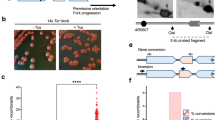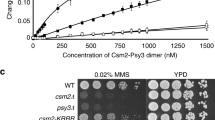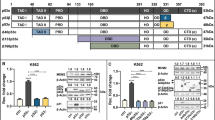Abstract
p53 plays a central role in the maintenance of the genome integrity, both as a gatekeeper and a caretaker. Sequence-specific recognition of DNA is underlying the ability of p53 to transcriptionally transactivate target genes during checkpoint control and to regulate DNA replication at the TGCCT repeat from the ribosomal gene cluster (RGC). In contrast, suppression of recombination by p53 has been observed with nonconsensus DNA sequences. In this study, we discovered that wild-type p53 stimulates homologous recombination adjacent to the RGC repeat, whereas downregulation is seen with a mutated version thereof and with a microsatellite repeat sequence. Analysis of the causes possibly underlying the enhancement of homologous recombination revealed that p53 binding to the RGC element delays DNA synthesis. This was demonstrated after integration of the corresponding DNA fragments into our Simian virus 40-based model system, which was used to study recombination on replicating minichromosomes. Differently, with plasmid-based substrates, p53 did not stimulate recombination at the RGC sequence. Thus, in combination with our previous findings, p53 may promote homologous recombination by two separate mechanisms involving either molecular interactions with topoisomerase I or/and by specific binding to certain genomic regions, thereby causing replication fork stalling and recombination.
This is a preview of subscription content, access via your institution
Access options
Subscribe to this journal
Receive 50 print issues and online access
$259.00 per year
only $5.18 per issue
Buy this article
- Purchase on Springer Link
- Instant access to full article PDF
Prices may be subject to local taxes which are calculated during checkout





Similar content being viewed by others
References
Achanta G, Pelicano H, Feng L, Plunkett W and Huang P . (2001). Cancer Res., 61, 8723–8729.
Ahrendt SA, Decker PA, Doffek K, Wang B, Xu L, Demeure MJ, Jen J and Sidransky D . (2000). Cancer Res., 60, 2488–2491.
Akyüz N, Boehden GS, Süsse S, Rimek A, Preuss U, Scheidtmann KH and Wiesmüller L . (2002). Mol. Cell. Biol., 22, 6306–6317.
Albrechtsen N, Dornreiter I, Grosse F, Kim E, Wiesmüller L and Deppert W . (1999). Oncogene, 18, 7706–7717.
Ariizumi K, Ghosh MR and Tucker PW . (1993). Mol. Cell. Biol., 13, 5629–5636.
Bargonetti J, Friedman PN, Kern SE, Vogelstein B and Prives C . (1991). Cell, 65, 1083–1091.
Boehden GS, Akyüz N, Roemer K and Wiesmüller L . (2003). Oncogene, 22, 4111–4117.
Boehden GS, Restle A, Marschalek R, Stocking C and Wiesmüller L . (2004). Carcinogenesis, 25, 1305–1313.
Bowater RP, Rosche WA, Jaworski A, Sinden RR and Wells RD . (1996). J. Mol. Biol., 264, 82–96.
Brazdova M, Palecek J, Cherny DI, Billova S, Fojta M, Pecinka P, Vojtesek B, Jovin TM and Palecek E . (2002). Nucleic Acids Res., 30, 4966–4974.
Contente A, Dittmer A, Koch MC, Roth J and Dobbelstein M . (2002). Nat. Genet., 30, 315–320.
Danaee H, Nelson HH, Karagas MR, Schned AR, Ashok TDS, Hirao T, Perry AE and Kelsey KT . (2002). Oncogene, 21, 4894–4899.
Defossez PA, Keil RL and Guarente L . (1999). Mol. Cell, 3, 447–455.
Dudenhöffer C, Kurth M, Janus F, Deppert W and Wiesmüller L . (1999). Oncogene, 18, 5773–5784.
Dudenhöffer C, Rohaly G, Will K, Deppert W and Wiesmüller L . (1998). Mol. Cell. Biol., 18, 5332–5342.
El-Deiry WS, Kern SE, Pietenpol JA, Kinzler KW and Vogelstein B . (1992). Nat. Genet., 1, 45–49.
Farmer G, Bargonetti J, Zhu H, Friedman P, Prywes R and Prives C . (1992). Nature, 358, 83–86.
Flores-Rozas H and Kolodner RD . (2000). Trends Biochem. Sci., 25, 196–200.
Gebow D, Miselis N and Liber HL . (2000). Mol. Cell. Biol., 20, 4028–4035.
Gerber JK, Gögel E, Berger C, Wallisch M, Müller F, Grummt I and Grummt F . (1997). Cell, 90, 559–567.
Janz C, Süsse S and Wiesmüller L . (2002). Oncogene, 21, 2130–2140.
Janz C and Wiesmüller L . (2002). Oncogene, 21, 5229–5933.
Jaxel C, Kohn KW and Pommier Y . (1988). Nucleic Acids Res., 16, 11157–11170.
Jeffers JR, Parganas E, Lee Y, Yang C, Wang JL, Brennan J, MacLean KH, Han J, Chittenden T, Ihle JN, McKinnon PJ, Cleveland JL and Zambetti GP . (2003). Cancer Cell, 4, 321–328.
Kanda T, Segawa K, Ohuchi N, Mori S and Ito Y . (1994). Mol. Cell. Biol., 14, 2651–2663.
Kern SE, Kinzler KW, Bruskin A, Jarosz D, Friedman P, Prives C and Vogelstein B . (1991). Science, 252, 1708–1711.
Kern SE, Pietenpol JA, Thiagalingam S, Seymour A, Kinzler KW and Vogelstein B . (1992). Science, 256, 827–830.
Kobayashi T, Heck DJ, Nomura M and Horiuchi T . (1998). Genes Dev., 12, 3821–3830.
Kobayashi T and Horiuchi T . (1996). Genes Cells, 1, 465–474.
Miller SD, Farmer G and Prives C . (1995). Mol. Cell. Biol., 15, 6554–6560.
Pluciennik A, Iyer RR, Napierala M, Larson JE, Filutowicz M and Wells RD . (2002). J. Biol. Chem., 277, 34074–34086.
Richard GF and Paques F . (2000). EMBO Rep., 1, 122–126.
Rothstein R, Michel B and Gangloff S . (2000). Genes Dev., 14, 1–10.
Rubbi CP and Milner J . (2003). EMBO J., 22, 975–986.
Saintigny Y, Delacote F, Vares G, Petitot F, Lambert S, Averbeck D and Lopez B . (2001). EMBO J., 20, 3861–3870.
Saintigny Y and Lopez BS . (2002). Oncogene, 21, 488–492.
Saintigny Y, Rouillard D, Chaput B, Soussi T and Lopez BS . (1999). Oncogene, 18, 3553–3565.
Sengupta S, Linke SP, Pedeux R, Yang Q, Farnsworth J, Garfield SH, Valerie K, Shay JW, Ellis NA, Wasylyk B and Harris CC . (2003). EMBO J., 22, 1210–1222.
Stephan H, Grosse F and Soe K . (2002). Nucleic Acids Res., 30, 5087–5093.
Toft NJ, Curtis LJ, Sansom OJ, Leitch AL, Wyllie AH, te Riele H, Arends MJ and Clarke AR . (2002). Oncogene, 21, 6299–6306.
Tsui S, Anderson ME and Tegtmeyer P . (1989). J. Virol., 63, 175–183.
Vogelstein B, Lane D and Levine AJ . (2000). Nature, 408, 307–310.
Wiesmüller L, Cammenga J and Deppert WW . (1996). J. Virol., 70, 737–744.
Willers H, McCarthy EE, Wu B, Wunsch H, Tang W, Taghian DG, Xia F and Powell SN . (2000). Oncogene, 19, 632–639.
Xiao G, White D and Bargonetti J . (1998). Oncogene, 16, 1171–1181.
Yoon D, Wang Y, Stapleford K, Wiesmüller L and Chen J . (2004). J. Mol. Biol., 336, 639–654.
Zhai W and Comai L . (2000). Mol. Cell. Biol., 20, 5930–5938.
Acknowledgements
We are grateful to Richard P Bowater, University of East Anglia Norwich, and Robert D Wells, Texas Medical Center, for construct pRW3246, to Professor Dr B Vogelstein, John Hopkins Oncology Center, Baltimore, for pSK-45-13-2-PyCAT and pSK-89-15-1-PyCAT. We thank Evelyn Bendrat for experimental assistance with DNA cloning. This work was supported by the Dr Mildred Scheel Stiftung (Deutsche Krebshilfe) Grant 10-1907-Wi 2, by the Deutsche Forschungsgemeinschaft Grant Wi 1376/3-1, and by the Land Baden-Württemberg, Forschungsschwerpunktprogramm: Fehlregulation von Apoptose als Grundlage für Krankheit.
Author information
Authors and Affiliations
Corresponding author
Rights and permissions
About this article
Cite this article
Boehden, G., Baumann, C., Siehler, S. et al. Wild-type p53 stimulates homologous recombination upon sequence-specific binding to the ribosomal gene cluster repeat. Oncogene 24, 4183–4192 (2005). https://doi.org/10.1038/sj.onc.1208592
Received:
Revised:
Accepted:
Published:
Issue Date:
DOI: https://doi.org/10.1038/sj.onc.1208592
Keywords
This article is cited by
-
High-speed rail model reveals the gene tandem amplification mediated by short repeated sequence in eukaryote
Scientific Reports (2022)
-
p53 in recombination and repair
Cell Death & Differentiation (2006)



